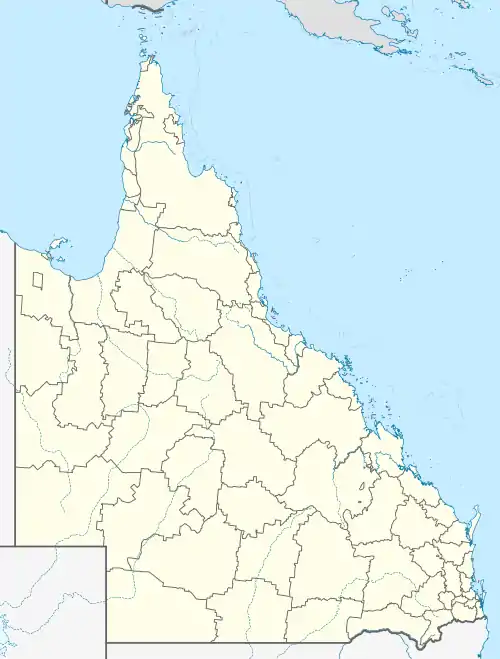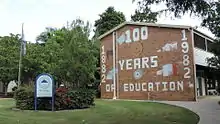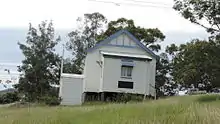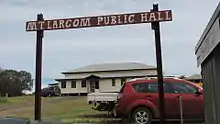Mount Larcom, Queensland
Mount Larcom is the name of a mountain, a township and a locality in the Gladstone Region, Queensland, Australia.[2][3][4] The township/locality is at the junction of the Bruce Highway and Gladstone Mount Larcom Road (State Route 58) approximately 70 kilometres (43 mi) south of the city of Rockhampton.[5]
| Mount Larcom Queensland | |||||||||||||||
|---|---|---|---|---|---|---|---|---|---|---|---|---|---|---|---|
 Gladstone Street, 2014 | |||||||||||||||
 Mount Larcom | |||||||||||||||
| Coordinates | 23°48′37″S 150°58′42″E | ||||||||||||||
| Population | 278 (2011 census)[1] | ||||||||||||||
| Postcode(s) | 4695 | ||||||||||||||
| Location | |||||||||||||||
| LGA(s) | Gladstone Region | ||||||||||||||
| State electorate(s) | Gladstone | ||||||||||||||
| Federal Division(s) | Flynn | ||||||||||||||
| |||||||||||||||
History
Naming
Commander Matthew Flinders named Mount Larcom (the mountain) on 4 August 1802, after a Royal Navy colleague Captain Thomas Larcom.[2] For most of the colonial period the spelling for the name of the region around the mountain was Mount Larcombe. It reverted to the spelling of Mount Larcom in the early 1900s.
British colonisation
In 1854, the region was made available for pastoral farming by the colonial British Government of New South Wales.[6] The following year, William Young, a Scottish colonist who was previously a storekeeper at Gayndah, established the Mount Larcombe sheep station.[7]
Frontier conflict of the 1850s
Frontier conflict between British colonists and the Aboriginal residents at Mount Larcombe, like in many other parts of Australia, was severe. William Young gave food and clothing to the local Aboriginal people in exchange for their land and their labour shearing his sheep, but also drove them away when they were not needed. He once kicked and pointed a gun at an Aboriginal man for not leaving a hut when told to. Native Police troopers were stationed on the property and in November 1855 they opened fire on a group of Aboriginal people at Mount Larcombe killing one. It was thought that some of the people shot at were involved in an attack a month earlier on the Native Police barracks located at nearby Rannes.[8][9]
In late December 1855, those that survived the shooting mounted a revenge attack on Mount Larcombe, taking sheep and supplies, and killing five station-hands including three men, one woman and an Aboriginal servant. William Young was away at Gladstone at the time reporting the drowning death of his superintendent. He was quickly informed of the killings and a punitive expedition was organised under the command of Lieutenant John Murray of the Native Police. Murray's group set out and later surrounded a camp of sleeping Aboriginal people at Hourigan's Creek. They subsequently killed a large number of people there and then tracked down other groups of Indigenous people in the following weeks as far as the northern banks of the Fitzroy River shooting them as they found them.[9][10][11]
Mount Larcombe sheep station was subjected to another series of killings in 1858. In October of that year, another three station-hands were killed by Aboriginal people. Second Lieutenant Frederick Wheeler of the Native Police was ordered to investigate the killings. Wheeler together with his troopers and William Young tracked down several camps of Aboriginal people but was only able to take seven female prisoners. Wheeler wrote in his report that they "were not able to shoot any...cannot say whether any of the murderers are amongst the mob, but they must all suffer, for the innocent must be held responsible for the guilt of others...going to Gladstone tomorrow but do not suppose to be able to shoot any." After resupplying at Gladstone, Wheeler set out again along the coastal estuaries where "some firing took place but unluckily no blacks were shot." Lieutenant John Murray with his own detachment of troopers then joined with Wheeler's group at Mount Larcombe and together set out on a large punitive expedition to the upper reaches of the Calliope River. Murray later reported that they came upon a large camp of Aboriginal people in that region and shot dead five of them, expressing disappointment that not more had been killed. Heavy rain interrupted further punitive measures and Wheeler and Murray returned to their barracks. Murray left instructions to Wheeler to conduct further operations to track down Aboriginal people when resupplied and the weather improved.[9]
20th Century to present day
In 1909 township allotments were advertised for sale as 'Mt Larcombe Estate', with the map showing the Gladstone railway station adjacent to the property.[12][13]
Mount Larcombe Provisional School opened on 13 November 1882, but closed for some time during the 1890s due to low student numbers. In 1909, it was upgraded to be Mount Larcombe State School and was renamed Mount Larcom State School in 1913. In 1964, a secondary department (Years 8-10) was added to the school.[14][15]
Mount Larcom Post Office opened by December 1909 (a receiving office had been open from 1904, first known as Mount Larcombe).[16]
Butlerville State School opened on 18 February 1918 but closed circa 1919.[17] In 1922 it reopened in 1922 and closed permanently in 1927.[18][19] The school was located on a 5-acre (2.0 ha) site on the western side of The Narrows Road (23.7525°S 151.0324°E).[20][21]
The first of Mount Larcom's annual agricultural shows was held on 8 October 1919. It was opened by George Carter, the Member of the Queensland Legislative Assembly for Port Curtis.[22]
On Sunday 16 July 1922 the Catholic church was opened by Bishop of Rockhampton Joseph Shiel. It was named for Our Lady of Mount Carmel. The land cost £64 and the church building cost £441.[23]
The ambulance station first opened in 1924; its replacement opened on 20 December 2001.[24]
The Mount Larcom library building opened in 2004.[25]
At the 2011 census, Mount Larcom had a population of 278.[1]
Heritage listings
Mount Larcom has a number of heritage-listed sites, including:
Geography

The mountain, rising to 632 metres (2,073 ft) [29] , is slightly east of the township and is a dominant feature on the horizon, especially from the town of Gladstone. It was named by Matthew Flinders after a Naval Captain that he served under.
Transport
Mount Larcom railway station is on the North Coast railway line, with long-distance passenger trains operated by Queensland Rail stopping here and a direct line to Gladstone.
Education

Mount Larcom State School is a government co-education primary school with a secondary department(P-10) located in Raglan Street. In 2013, the school had 89 pupils and 10 teachers. For high school education beyond Year 10, students must travel to other high schools; the nearest is in Gladstone.[30][31]
Amenities




The Mount Larcom Library is on Raglan Street; it is operated by the Gladstone Regional Council.[32]
There is a Catholic church, Our Lady of Mount Carmel, at 24 Balfour Street. Each month there is a mass and a lay-led liturgy.[33]
There is a public hall in Raglan Street.
Despite its small population, Mount Larcom has a police station (Gladstone Street), an ambulance station (Raglan Street), a volunteer Rural Fire Service and a volunteer State Emergency Service group. However, the nearest hospitals are in Gladstone and Rockhampton. Being located near the junction of two highways, a common emergency is vehicle crashes.[24]
The Mount Larcom branch of the Queensland Country Women's Association meets at 4 King George Street.[34]
The Royal Hotel is on Raglan Street next door to the Mount Larcom Café and Collectables.
Events
The Mount Larcom and District Show Society organise an annual agricultural show in June each year. In 2014, in addition to the livestock competitions, there are other activities including a ute muster, woodchopping and fireworks.[35]
References
- Australian Bureau of Statistics (31 October 2012). "Mount Larcom (SSC)". 2011 Census QuickStats. Retrieved 20 April 2014.

- "Mount Larcom (mountain) (entry 19010)". Queensland Place Names. Queensland Government. Retrieved 20 April 2014.
- "Mount Larcom (town) (entry 23063)". Queensland Place Names. Queensland Government. Retrieved 20 April 2014.
- "Mount Larcom (locality) (entry 46614)". Queensland Place Names. Queensland Government. Retrieved 20 April 2014.
- Google (13 August 2019). "Mount Larcom, Queensland" (Map). Google Maps. Google. Retrieved 13 August 2019.
- "PORT CURTIS". New South Wales Government Gazette (3). New South Wales, Australia. 10 January 1854. p. 49. Retrieved 27 October 2020 – via National Library of Australia.
- "The late Mr. Wm. Young". The Brisbane Courier. LIV (12, 575). Queensland, Australia. 2 May 1898. p. 6. Retrieved 27 October 2020 – via National Library of Australia.
- "TRUTH'S TRU TALES". Truth (255). Queensland, Australia. 25 December 1904. p. 3. Retrieved 28 October 2020 – via National Library of Australia.
- Skinner, Leslie Edward (1 January 1975), Police of the pastoral frontier : native police, 1849-1859, University of Queensland Press, retrieved 28 October 2020
- "Spirits and tobacco". The Sydney Morning Herald. XXXVII (5548). New South Wales, Australia. 18 February 1856. p. 5. Retrieved 28 October 2020 – via National Library of Australia.
- "Along the coast". The Capricornian. 26 (24). Queensland, Australia. 16 June 1900. p. 41. Retrieved 28 October 2020 – via National Library of Australia.
- "Mt. Larcombe Estate : Gladstone". 1909. hdl:10462/deriv/251726. Cite journal requires
|journal=(help) - "Advertising". The Week. LXVIII (1, 766). Queensland, Australia. 29 October 1909. p. 26. Retrieved 30 April 2019 – via National Library of Australia.
- "Opening and closing dates of Queensland Schools". Queensland Government. Retrieved 26 June 2014.
- "Agency ID 5532, Mount Larcom State School". Queensland State Archives. Retrieved 26 June 2014.
- Premier Postal History. "Post Office List". Premier Postal Auctions. Retrieved 10 May 2014.
- "NEW STATE SCHOOL". The Telegraph (13970). Queensland, Australia. 1 September 1917. p. 11. Retrieved 5 November 2020 – via National Library of Australia.
- Queensland Family History Society (2010), Queensland schools past and present (Version 1.01 ed.), Queensland Family History Society, ISBN 978-1-921171-26-0
- "Agency ID 8922, Butlerville State School". Queensland State Archives. Retrieved 5 November 2020.
- "Reserves". The Brisbane Courier (18, 640). Queensland, Australia. 13 October 1917. p. 3. Retrieved 5 November 2020 – via National Library of Australia.
- "Parish of Targinie" (Map). Queensland Government. 1975. Archived from the original on 5 November 2020. Retrieved 5 November 2020.
- "MT. LARCOM SHOW". The Brisbane Courier. National Library of Australia. 13 October 1919. p. 8. Retrieved 26 June 2014.
- "NEW CATHOLIC CHURCHES". The Morning Bulletin. Rockhampton, Qld.: National Library of Australia. 22 July 1922. p. 7. Retrieved 25 June 2014.
- "Mt Larcom Emergency Services". Mount Larcom Community. Archived from the original on 4 March 2016. Retrieved 26 June 2014.
- "Public Libraries Statistical Bulletin 2016-17" (PDF). Public Libraries Connect. State Library of Queensland. November 2017. p. 13. Archived (PDF) from the original on 30 January 2018. Retrieved 24 January 2018.
- "Mount Larcombe Station Original Homestead Site". Local Heritage Register. Gladstone Regional Council. Archived from the original on 25 April 2015. Retrieved 26 June 2014.
- "Mount Larcom Cemetery". Local Heritage Register. Gladstone Regional Council. Archived from the original on 25 April 2015. Retrieved 26 June 2014.
- "Mount Larcom Showground". Local Heritage Register. Gladstone Regional Council. Archived from the original on 25 April 2015. Retrieved 26 June 2014.
- "Mount Larcom Climb" (PDF). RACQ. RACQ. Retrieved 19 July 2017.
- "Queensland State and Non-State Schools". Queensland Government. Archived from the original on 8 May 2014. Retrieved 26 June 2014.
- "2013 School Annual Report" (PDF). Mount Larcom State School. Mount Larcom State School. Archived (PDF) from the original on 10 March 2015. Retrieved 26 June 2014.
- "Contact us". Gladstone Regional Libraries. Gladstone Regional Council. Archived from the original on 14 July 2014. Retrieved 23 June 2014.
- "Gladstone Parish". Catholic Diocese of Rochampton. Roman Catholic Diocese of Rockhampton. Archived from the original on 3 September 2014. Retrieved 24 June 2014.
- "Branch Locations". Queensland Country Women's Association. Archived from the original on 26 December 2018. Retrieved 26 December 2018.
- "Schedules". Mount Larcom and District Show Society. Mount Larcom and District Show Society. Archived from the original on 28 April 2014. Retrieved 26 June 2014.
Further reading
- Tully, Judith; Mount Larcom State School Jubilee Committee (2007), Mount Larcom State School & Secondary Department 125th jubilee, 1882–2007, Jubilee Committee
- Queensland Ambulance Transport Brigade. Mt. Larcom Centre (1974), Queensland Ambulance Transport Brigade, Mount Larcom Centre : golden jubilee, 1924–1974, QATB
- Holborow, Janice (1999), Mount Larcom & District Show history 1919–1999, s.n
External links
| Wikimedia Commons has media related to Mount Larcom, Queensland. |